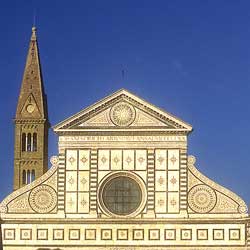|  The
Domenican monks established themselves in Santa Maria Novella in the same
period and in a geographically-symmetrical way to that of the Franciscans
of Santa Croce. The
Domenican monks established themselves in Santa Maria Novella in the same
period and in a geographically-symmetrical way to that of the Franciscans
of Santa Croce.
From 1221, when they obtained the church of Santa Maria delle Vigne (at
that time outside the city walls), the Dominicans began to develop the
monastery complex of Santa Maria Novella, starting work around about 1245.
The construction of the church was entrusted to two architect monks:
Ristoro da Campi and Sisto da Firenze; building work began in 1279 and
was completed in 1325 under the supervision of Frà Jacopo Talenti,
who was also responsible for the bell-tower.
The facade of the church was financed (as can be seen by the inscription
on it) by Giovanni Rucellai, who commissioned Leon Battista Alberti to
carry out the task. He completed it in 1470, producing an original and
harmonious covering, a fusion of ancient Gothic and Renaissance innovation,
using the classical colours of white and green marble.
The interior of the church has a wealth of art works and frescos, and
there is an extremely beautiful pulpit designed by Brunelleschi.
The Santa Maria Novella complex also includes the monastery with the
large cloister and the distinctive green cloister, the museum (of the
same name), the pharmacy, and the extensive piazza onto which the church
faces.
The church has witnessed and been involved in many memorable events: St.
Thomas Aquinas, St. Catherine of Siena, and Pope Marino V all came here,
the latter consecrating the church during the lengthy period of his stay
in the city; Pope Eugenio IV was present for the important Council of
Firenze in 1439. In the sixteenth century, Grand Duke Cosimo I had the
Spaniards who came to the city with his wife Eleonora put up in the Sala
del Capitolo, and this is the reason why the room is known as the Salone
degli Spagnoli.
The court of the Inquisition was also held in this church.
Like the other important churches of the city, Santa Maria Novella also
allowed the important Florentine families to have their own chapels, which
were frescoed by excellent artists. The piazza is embellished with two
obelisks from the sixteenth and nineteenth centuries, and was the site
for the popular "corsa dei cocchi". In 1933, it was partially
transformed into a garden, with triangular-shaped lawns and a round marble
basin in the middle.
The piazza was originally used by the monks for their sermons, then
it was used for religious spectacles, and during the Inquisition those
people found guilty of heresy or witchcraft were put on display here.
The name Santa Maria Novella has also been given to the main railway station
in Firenze, which is just across from the church.
Picture by Sandro Santioli
Translated by Jeremy Carden
|